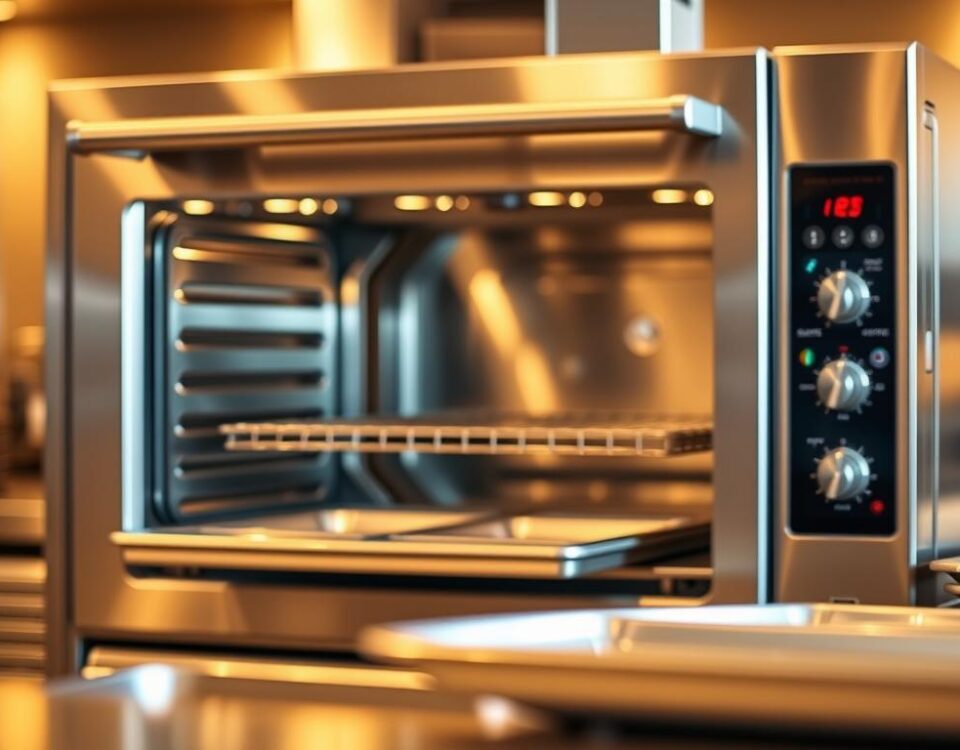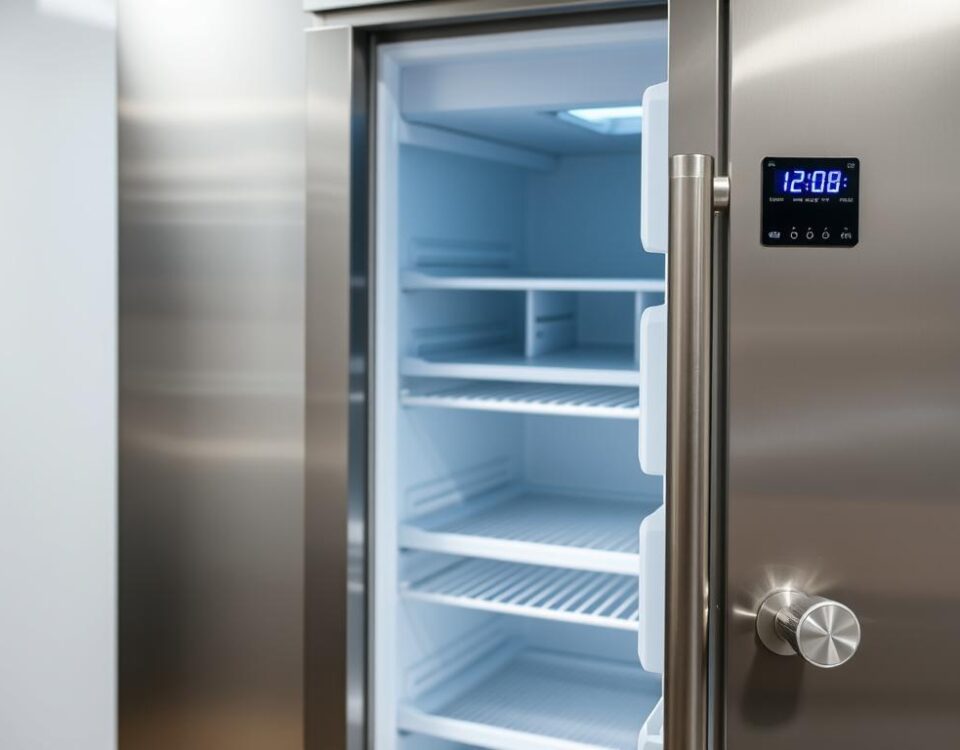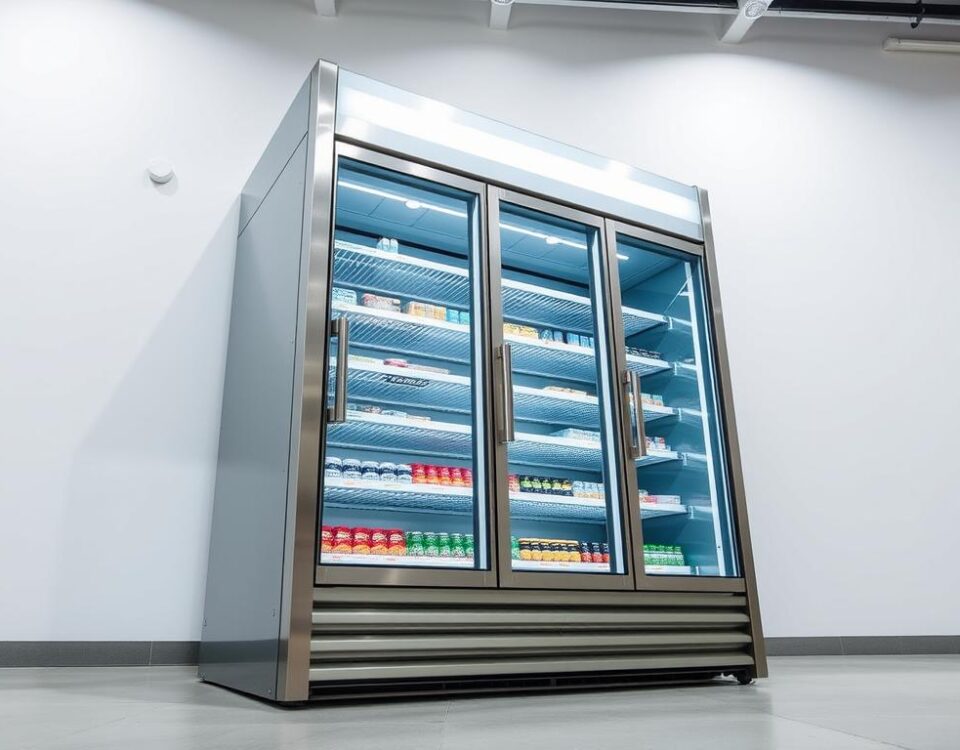
Why Pressure Fryers Cook the Juiciest Chicken (Backed by Data)
September 12, 2025
Gas vs Electric Fryer Operating Cost: Real Numbers Revealed
September 13, 2025As a restaurant owner, I’ve experienced the frustration of serving soggy fries to hungry customers. It’s a problem that can be avoided by investing in the right commercial fryer. With the kitchen equipment market flooded with options, choosing between top brands like Pitco and Frymaster can be daunting.
A staggering 70% of restaurants rely on gas fryers for their cooking needs, and for good reason – they offer faster recovery times and more precise temperature control. But with so much at stake, how can you be sure which brand will deliver the crispier results your customers crave?
As we dive into this comparison, we’ll examine the key factors that set these industry leaders apart, from heating technology to oil management, and explore which brand is best equipped to meet your kitchen’s needs.
Key Takeaways
- Understand the importance of choosing the right commercial fryer for your restaurant’s success
- Compare the heating technology used by Pitco and Frymaster fryers
- Learn how oil management systems impact food quality
- Discover which brand offers better energy efficiency
- Find out which fryer is best suited for your kitchen’s specific needs
Understanding Commercial Fryers: The Backbone of Restaurant Kitchens
Commercial fryers are the unsung heroes of restaurant kitchens, playing a crucial role in delivering crispy delights to customers. Fried foods, whether battered, breaded, or lightly crisped, are mainstays on menus across various dining concepts.
These fryers are considered essential kitchen equipment for establishments across the dining spectrum, processing everything from appetizers to main courses. The choice of fryer directly impacts food quality, particularly in terms of oil absorption rates, heat recovery times, and temperature consistency.
Why Your Fryer Choice Matters for Food Quality
The type of fryer you choose can significantly affect the quality of your fried foods. Factors such as cooking temperature control, oil management, and the type of fryer (whether it’s gas or electric) play crucial roles. For instance, gas fryers are known for their quick heat recovery, while electric fryers offer precise temperature control.
The Impact of Fryer Technology on Crispiness
Advanced fryer technology has evolved to address common kitchen challenges, including oil management and energy efficiency. Modern fryers are designed to ensure consistent cooking results across different food types, enhancing crispiness and reducing oil absorption. By choosing the right fryer for your kitchen, you can improve food quality and operational efficiency.
Pitco vs Frymaster Fryer: A Head-to-Head Comparison

When it comes to commercial fryers, two brands stand out: Pitco and Frymaster. Both have established themselves in the industry, but they have distinct differences that can impact your kitchen’s efficiency and food quality.
Company Background and Reputation
Pitco has been at the forefront of innovation with its forced convection technology, enhancing cooking consistency and reducing oil usage. Frymaster, on the other hand, is known for its reliable and serviceable fryers, with a reputation for durability in busy commercial kitchens.
Product Line Overview
Pitco’s product line includes the Reduced Oil Volume/High Output Rack Frying System, which boasts high-production frying racks and a space-saving filter system. Frymaster’s FilterQuick30 Series II has been redesigned for improved reliability and serviceability, featuring an easyTouch controller for enhanced diagnostics.
Price Point Comparison
While both brands offer high-quality fryers, their pricing strategies differ. Pitco’s advanced technology often comes at a higher initial cost, but it can lead to long-term savings through reduced oil consumption. Frymaster’s focus on reliability and serviceability can also impact the total cost of ownership, making it essential to consider both initial investment and ongoing expenses.
By examining the company background, product offerings, and pricing of Pitco and Frymaster, you can make an informed decision that suits your kitchen’s specific needs and budget.
Gas vs Electric: Which Power Source Delivers Better Results?
Choosing the right power source for your commercial fryer is crucial, as it affects not only the taste but also the crispiness of your food. The decision between gas and electric fryers depends on several factors, including utility costs, kitchen ventilation, and specific cooking needs.
Both gas and electric fryers can produce high-quality fried foods, but they have different characteristics. Gas fryers are known for their faster cycle times, heating up and cooling down more quickly than electric models. This makes them particularly suitable for high-volume kitchens where speed and efficiency are paramount.
Pitco’s Approach to Gas and Electric Fryers
Pitco’s gas fryers utilize their innovative TorQ™ forced convection system, which optimizes heat transfer for consistent cooking results. This technology ensures that food is cooked evenly, achieving the desired crispiness. On the other hand, Pitco’s electric fryers feature directly submerged heating elements, creating a large surface area for direct heat transfer, which can be beneficial for certain types of food.
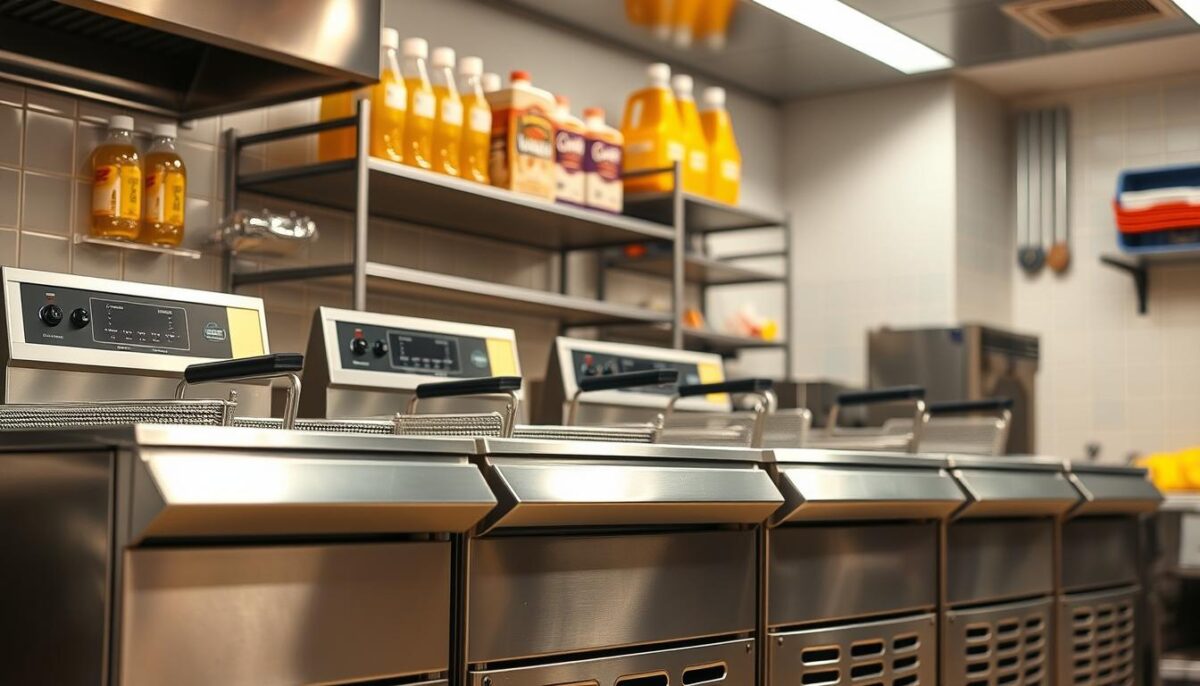
Frymaster’s Gas and Electric Options
Frymaster’s gas fryers are equipped with high-efficiency burner designs, contributing to faster recovery times and even heating throughout the cooking process. Their electric fryers also offer advanced heating elements that provide consistent performance. Understanding the specifics of each manufacturer’s technology is key to making an informed decision based on your kitchen’s needs.
Ultimately, the choice between gas and electric fryers should be based on a thorough analysis of your kitchen’s operations, including utility costs, ventilation requirements, and the type of menu items you serve. By considering these factors, you can determine which power source will deliver better results for your specific needs.
Oil Management Systems: Extending Oil Life and Improving Taste
Oil management systems play a vital role in extending oil life and improving the overall taste of fried foods. As oil costs continue to rise, making it one of the costliest budget lines in an operation, manufacturers are focusing on helping operators extend the life of their oil. One effective method is to have an adequate cold zone to remove particles from the cooking oil before they degrade it. Regular and consistent filtration is another crucial approach.
Both Pitco and Frymaster have prioritized filtration technology in their fryer designs, recognizing its impact on operational costs and food quality. Let’s examine the specifics of each brand’s approach to oil management.
Pitco’s Filtration Technology
Pitco’s continuous in-line filtration system removes food particles during the cooking process, not just between batches. This technology potentially extends oil life significantly by maintaining cleaner oil throughout the cooking process. Pitco’s system is designed to simplify the filtration process, making it easier for kitchens to maintain high oil quality.
Frymaster’s FilterQuick System
Frymaster’s FilterQuick system offers an automated approach to oil filtration. Its design aims to simplify the filtration process while maximizing oil lifespan. The FilterQuick system is part of Frymaster’s effort to reduce labor requirements associated with manual filtration, making it a convenient option for busy kitchens.
Impact on Food Taste and Crispiness
The quality of the oil directly affects the taste and crispiness of fried foods. Cleaner oil leads to less absorption, better heat transfer, and ultimately crispier, better-tasting foods. By comparing the effectiveness of both brands’ filtration technologies, we can see how they impact labor requirements, oil consumption, and food taste in real-world kitchen environments.
| Feature | Pitco | Frymaster |
|---|---|---|
| Filtration System | Continuous In-Line Filtration | FilterQuick System |
| Automation Level | High | High |
| Impact on Oil Life | Significantly extends oil life | Maximizes oil lifespan |
Heating Technology: How Each Brand Approaches Heat Transfer
When it comes to commercial fryers, the heating technology used can significantly impact the crispiness of fried foods. The way a fryer applies heat to the oil affects not only the cooking process but also the longevity of the oil and the overall quality of the food.
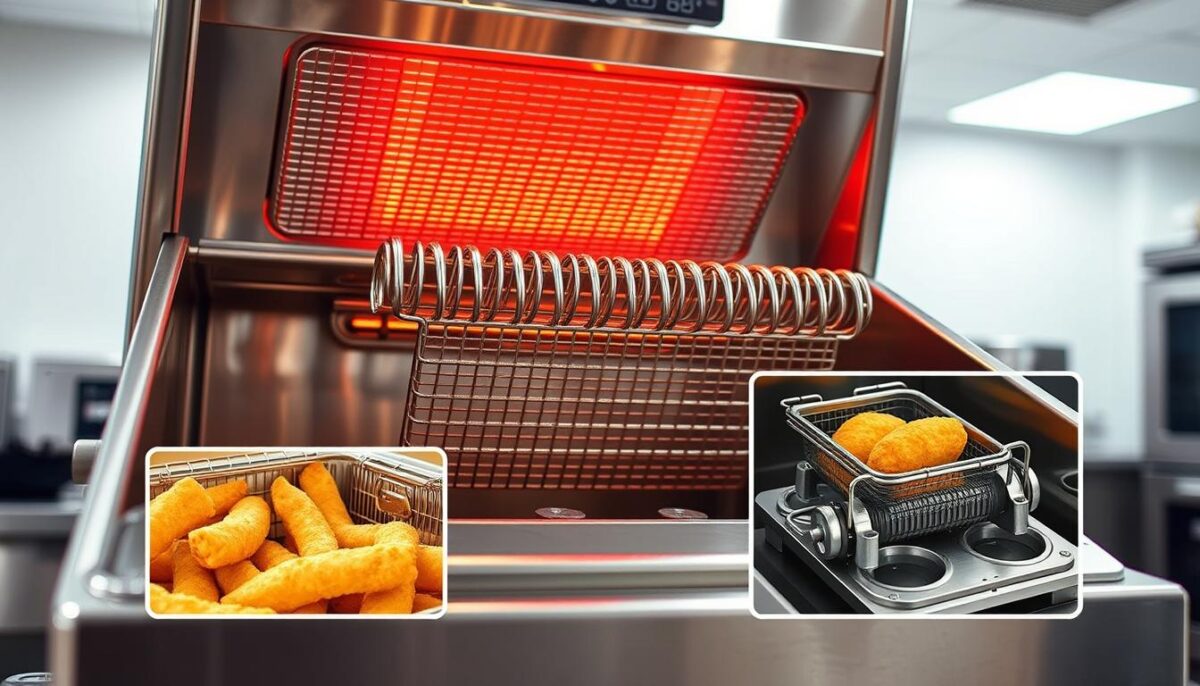
Tube-Type vs Open-Pot Designs
Commercial fryers differ in their heating technology, with two main designs: tube-type and open-pot. Tube-type fryers have heated tubes submerged in the oil, which radiates heat and allows for fast recovery times. However, these can be challenging to clean due to the welded tubes. On the other hand, open-pot fryers heat the walls of the pot, radiating heat to the oil inside, making them easier to clean and service.
Pitco’s TorQ™ Forced Convection Technology
Pitco’s innovative TorQ™ forced convection technology combines the benefits of gas fryers with advanced heat circulation. This technology ensures faster cooking times and more consistent results by circulating heat more efficiently than traditional systems. It’s particularly beneficial for high-volume operations where maintaining consistent oil temperatures is crucial.
Frymaster’s Heating Elements and Recovery Time
Frymaster’s approach to heating elements focuses on rapid recovery times, ensuring that the oil returns to the optimal cooking temperature quickly after food is submerged. This is particularly important in busy kitchens where continuous frying is necessary. Their design helps maintain consistent oil temperatures, which is key to achieving crispy results.
The heating technology used in commercial fryers has a direct impact on food quality, oil longevity, and kitchen efficiency. By understanding the differences between tube-type and open-pot designs, as well as the innovative technologies employed by Pitco and Frymaster, kitchen operators can make informed decisions to optimize their frying operations.
Energy Efficiency and Operating Costs
In the world of commercial frying, energy efficiency is not just a buzzword – it’s a bottom-line issue. As restaurant owners and managers, you’re constantly looking for ways to reduce costs without compromising on food quality. One crucial aspect to examine is the energy efficiency of your commercial fryer.
Some gas fryer models boast an Energy Star rating, indicating at least 50% energy efficiency, with some models reaching up to 70% efficiency. In contrast, non-Energy-Star-rated fryers average around 43% efficiency. This difference translates to significant energy consumption and operating costs.
Energy Star Ratings: A Comparative Analysis
When comparing Pitco and Frymaster product lines, Energy Star ratings become a critical differentiator. I’ll examine how these efficiency standards impact real-world energy consumption and operating costs in commercial kitchens. Energy-efficient fryers not only reduce utility bills but also enhance cooking performance by ensuring faster recovery times and less oil absorption.
- Pitco’s reduced oil volume designs vs. Frymaster’s oil management systems
- Impact of energy efficiency on cooking performance and crispiness
- Potential for utility rebates and tax incentives for energy-efficient models
Long-Term Cost Analysis
A comprehensive analysis of the total cost of ownership for both brands must consider purchase price, energy consumption, oil usage, and maintenance requirements. By factoring in these elements, restaurant owners can make an informed decision that balances initial costs with long-term savings.
By choosing an energy-efficient fryer, restaurants can significantly reduce their operating costs while maintaining the quality of their fried foods. It’s a decision that impacts not just the bottom line but also the environment and customer satisfaction.
Special Features and Innovations
Commercial fryers have become more than just cooking vessels; they’re now hubs of innovation and efficiency. As kitchens become increasingly sophisticated, manufacturers like Pitco and Frymaster are responding with advanced features that improve food quality, safety, and operational efficiency.
Pitco’s Continuous In-Line Filtration
Pitco’s continuous in-line filtration system is a standout innovation that filters oil during the cooking process, rather than between batches. This technology potentially extends oil life while maintaining consistent food quality. By reducing the need for frequent filtration, kitchens can operate more efficiently.
Frymaster’s easyTouch Controller
Frymaster’s easyTouch controller simplifies operation with its intuitive interface, providing enhanced diagnostics and helping ensure consistent cooking results across different operators. This feature is particularly valuable in high-turnover kitchens where staff may have varying levels of experience.
Smart Technology and Connectivity Options
Both Pitco and Frymaster offer smart technology and connectivity options, including cloud integration and remote monitoring capabilities. These features allow for programmable menu items to be deployed across multiple locations, enhancing operational consistency and flexibility.
The incorporation of automation features like auto-fill systems, basket lifts, and oil quality sensors further enhances operational efficiency and food consistency. By analyzing these special features, kitchen operators can determine which innovations provide the most value for their specific needs.
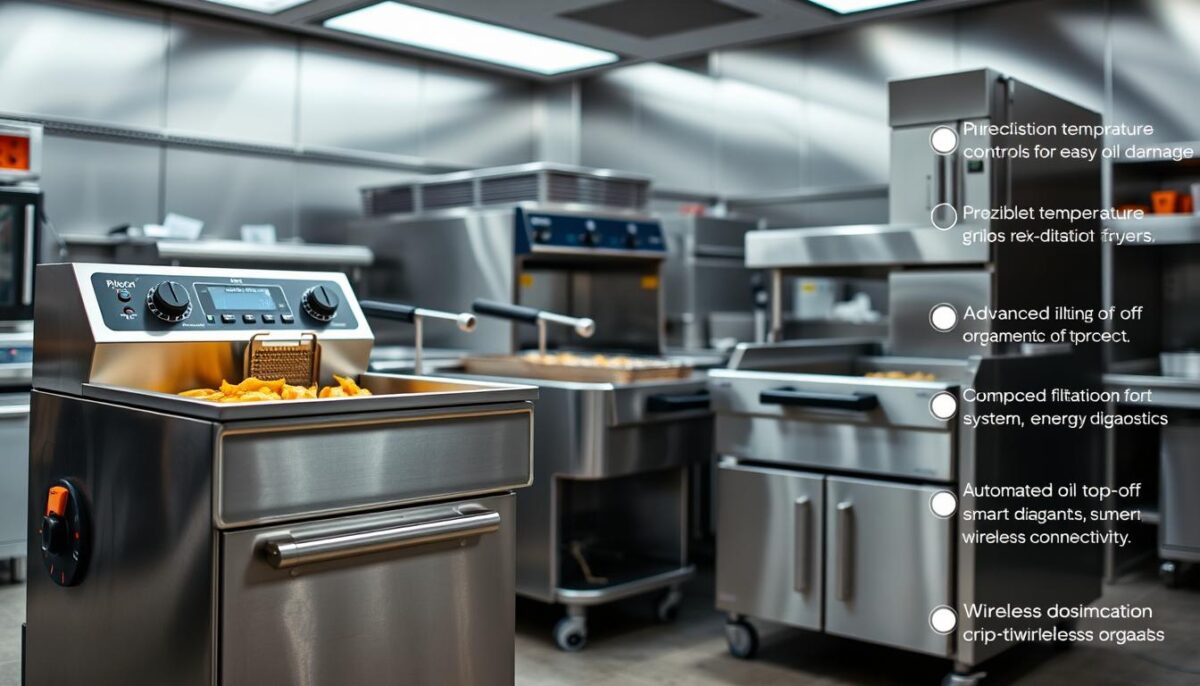
The Crispy Truth: Real-World Performance Results
In commercial cooking, the fryer is a critical component that directly impacts food crispiness. The efficiency of a fryer, along with its ability to maintain optimal temperature, plays a crucial role in achieving the desired crispiness.
Food Absorption Rates and Crispiness
The rate at which food absorbs oil significantly affects its crispiness. Pitco and Frymaster fryers have different oil capacity and heating technologies that influence oil absorption rates. Tests have shown that fryers with advanced temperature control and efficient heating elements result in lower oil absorption, leading to crisper food.
Consistency Across Different Food Types
Different foods, from breaded items to naked proteins, require consistent cooking results. The performance of gas fryers and electric fryers varies across these food types. By examining how Pitco and Frymaster fryers handle various foods, kitchens can choose the best fryer for their specific menu offerings, ensuring crispy results every time.
Conclusion: Making the Right Choice for Your Kitchen
Choosing the right fryer is crucial for any kitchen aiming to serve crispy, high-quality food. As we’ve seen, both Pitco and Frymaster offer high-performance fryers with unique strengths.
The decision between these brands depends on several factors, including your menu offerings, kitchen space, and budget. Consider whether you need a countertop model or a floor fryer, and whether gas or electric power suits your kitchen best.
After-sale support and maintenance requirements are also crucial. Look for brands with reliable service networks and readily available parts. By weighing these factors, you can confidently choose the fryer that will deliver the crispiest results for your specific culinary needs.
Ultimately, the right fryer will enhance your kitchen’s efficiency and the quality of your fried foods, making it a valuable investment in your business’s success.
## FAQ
### Q: What are the key differences between gas and electric commercial fryers?
A: Gas commercial fryers offer faster recovery times and more precise temperature control, while electric fryers are often more energy-efficient and easier to maintain. I find that gas fryers are ideal for high-volume kitchens, while electric fryers suit smaller operations.
### Q: How do I choose the right oil management system for my kitchen?
A: When selecting an oil management system, consider factors like oil capacity, filtration frequency, and ease of use. I recommend looking for systems with continuous in-line filtration, like Pitco’s, for optimal oil life and food quality.
### Q: What is the impact of heating technology on food crispiness?
A: Heating technology plays a crucial role in achieving crispy results. TorQ Forced Convection Technology, used by Pitco, and Frymaster’s heating elements both offer excellent heat transfer. I find that these technologies help maintain consistent temperatures, resulting in crisper food.
### Q: How can I reduce energy costs with my commercial fryer?
A: To minimize energy costs, look for fryers with Energy Star ratings and consider models with advanced insulation and smart technology. I recommend evaluating your fryer’s energy efficiency and operating costs to make informed decisions.
### Q: What are the benefits of using a countertop fryer versus a floor model?
A: Countertop fryers are ideal for smaller kitchens or limited spaces, offering flexibility and ease of use. I find that they are perfect for establishments with lower frying demands, while floor models suit high-volume operations.
### Q: How often should I filter my fryer oil?
A: Filtering frequency depends on usage, oil type, and food being cooked. I recommend filtering oil daily or after every 8-10 hours of use to maintain optimal oil quality and food taste.
### Q: Can I use different types of oil in my commercial fryer?
A: Yes, you can use various oils, but it’s essential to consider their smoke points, flavor profiles, and viscosity. I suggest choosing oils that suit your menu and cooking style to achieve the best results.
### Q: What safety features should I look for in a commercial fryer?
A: When selecting a commercial fryer, look for features like automatic shut-off, thermal overload protection, and secure drain valves. I recommend prioritizing safety to protect your staff and equipment.

